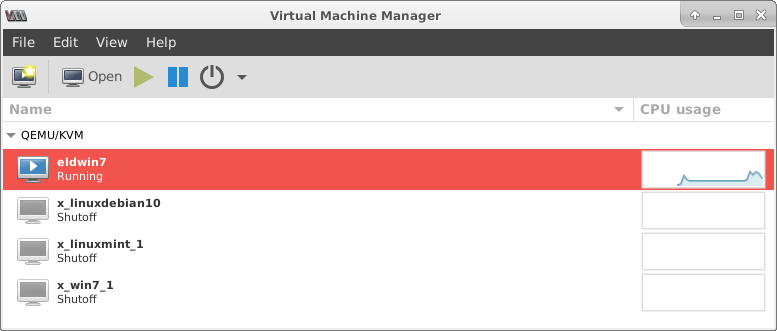Virt-manager is a desktop tool for managing virtual machines. It provides the ability to control the lifecycle of existing machines. Mar 28, 2021 The virt-manager application or package uses the libvirt library to provide virtual machine management services. It comes with a desktop interface that helps to create, delete, and manage multiple virtual machines. It is primarily used for KVM VMs but can support other hypervisors as well such as Xen, LXC. The user interface provides a summary.
Steps to configure bridged network in virt-manager. To configure bridged network in virt-manager for your virtual machine you must have a network bridge active on your host machine so make sure your host have an active working bridge network interface configured on your host machine. Next install virt-manager on your host machine. Install and verify KVM: $ sudo apt install qemu-kvm libvirt-bin ubuntu-vm-builder bridge-utils $ kvm.
Virt-manager Ubuntu
As we all know that the VMware and VirtualBox are not the only Virtualization software to create Virtual Machines on Linux. There are few others such as Qemu & KVM. These are the most popular command-line tools to create virtual or delete virtual machines. So, being a command-line tool, it becomes very difficult for both professional and beginner users of Linux to handle them. Since the long command to create and run Virtual Machines on Linux or Ubuntu is hard to remember. To solve this problem there are a variety of Virtual Manager tools are available and one of them is the Virt Manager.
Now, What is the Virt Manager?

The Virt Manager is an open-source application that is meant to provide a Graphical user interface to Virtualization software like QEMU/KVM. It is particularly meant to manage the Kernel-based Virtual Machine (KVM) using libvirt bin. However, other projects such as Xen and LXC (Linux containers) can be managed too. It provides users with a summary of their running VMs including live performance and resource utilization stats of them.
If you haven’t installed the Qemu on your system, yet, then here is the tutorial on it: Qemu Ubuntu Tutorial

So, I assumed that you already have the Qemu or KVM on your Ubuntu system. And now looking for a way to install the Virt-Manager Virtual machine manager for Ubuntu.
Here we are using Ubuntu 18.04 to install Virt-manager but the command the will be same of the older version such as Ubuntu 17.04, 16.04, 15.04…
Steps to install Virt Manager on Ubuntu via command line
- Go to your Ubuntuserver or Desktop.
- Open the Ubuntu Command Terminal. Shortcut for that is CTRL+ALT+T
- To install the Virt manager run the following command
- After the above command go to the applications and you will Virt Manager icon.
- Click on the Virt icon and start creating a virtual machine.
To increase the performance of Qemu on Virt Manager it’s recommended to install the KVM too.
For that first of all check, whether your machine’s CPU supports the KVM or not.
1. The command to check the KVM compatibility:
2. If your machine CPU supports the KVM then run the given command to install it:
Steps for creating Virtual machine on Virt Virtual machine manager in Linux
- Choose the medium to install the operating system. The options are Local install media (ISO image or CD-ROM), Network Install (HTTP, FTP or NFS), Network Boot (PXE), and Import existing disk image.
- If you want to install using ISO image then select that option and click on the Forward button.
- Browse the ISO image
- Set the Memory (RAM) and number of CPU
- Assign the amount of virtual hard disk space you want to give to your VM.
- Name your Virtual machine and click on the Finish button.
Uninstall the Virt-manager
In case you want to remove the Virt Manager GUI tool from Ubuntu then execute the following command in a command terminal.
In this way, the user can install the Virt- Manager on Ubuntu.
Other resources to read:
The virt-manager application is a desktop user interface for managing virtual machines through libvirt. It primarily targets KVM VMs, but also manages Xen and LXC (linux containers). It presents a summary view of running domains, their live performance & resource utilization statistics. Wizards enable the creation of new domains, and configuration & adjustment of a domain’s resource allocation & virtual hardware. An embedded VNC and SPICE client viewer presents a full graphical console to the guest domain.
About virt-manager’s supporting tools
virt-install is a command line tool which provides an easy way to provision operating systems into virtual machines.

Virt-manager Windows
virt-viewer is a lightweight UI interface for interacting with the graphical display of virtualized guest OS. It can display VNC or SPICE, and uses libvirt to lookup the graphical connection details.
virt-clone is a command line tool for cloning existing inactive guests. It copies the disk images, and defines a config with new name, UUID and MAC address pointing to the copied disks.
virt-xml is a command line tool for easily editing libvirt domain XML using virt-install’s command line options.
Virt Manager Fedora
virt-bootstrap is a command line tool providing an easy way to setup the root file system for libvirt-based containers.